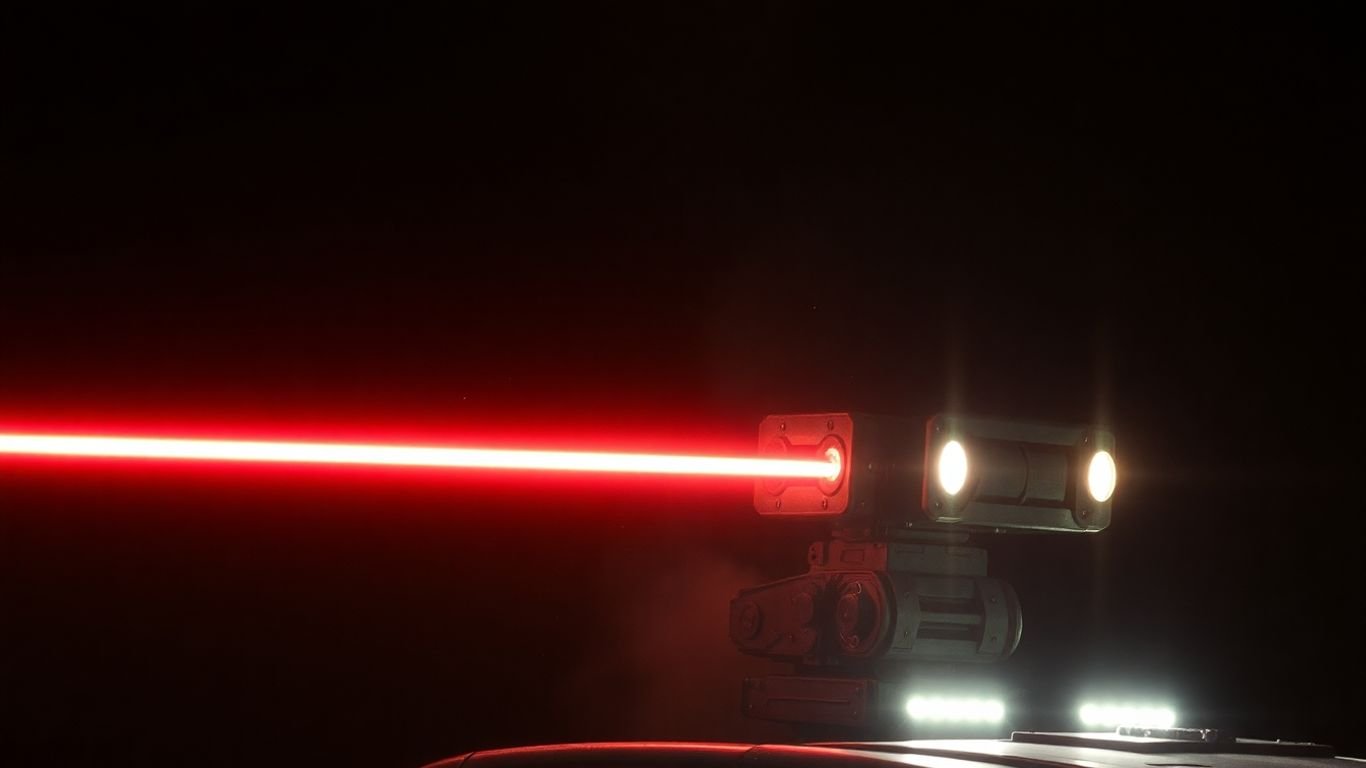Apollo Laser Weapon: Australia’s High-Energy Solution to Drone Threats

Drones are everywhere these days, and honestly, they’re becoming a real headache for military folks. They’re cheap, they can swarm, and they’re tough to shoot down with old-school methods. But guess what? Australia has cooked up something pretty cool to deal with it. It’s called the Apollo laser weapon, and it’s a big deal in how we fight back against these flying nuisances. This thing is supposed to be super precise and way cheaper than missiles, which sounds like a win-win.
Key Takeaways
- The Apollo laser weapon, made by an Australian company called EOS, is a new type of defense system that uses high-energy lasers to take down drones.
- It’s really good at hitting lots of drones quickly, even when they attack in big groups, and it’s much cheaper to use than missiles.
- This laser system is designed to be moved around easily and can work with other defense systems, including those used by NATO countries.
- There’s already a lot of interest from other countries, with the first big export deal already signed, showing that other nations want this kind of drone defense.
- Experts think laser weapons like Apollo are becoming really important for future battles, moving from just an idea to something needed on the battlefield.
The Apollo Laser Weapon: A New Era in Defense
The landscape of modern defense is changing fast, and Australia’s Electro Optic Systems (EOS) is right there with its Apollo laser weapon. This isn’t just another piece of military tech; it’s a whole new way to think about dealing with threats, especially those buzzing drones that seem to be everywhere these days. Apollo represents a significant step forward in high-energy laser defense systems.
Introducing Electro Optic Systems’ High-Energy Laser Weapon
EOS, a company known for its work in optics and lasers, has developed the Apollo system. It’s a high-energy laser defense solution designed to take on a variety of aerial threats. Think of it as a super-powered laser pointer, but instead of a cat, it’s targeting enemy drones. This Australian defense system is built to be powerful and precise, offering a new layer of protection.
Addressing the Evolving Drone Threat
Drones have gone from being a novelty to a serious military concern. They’re used for everything from spying to carrying explosives, and they’re getting harder to stop with traditional methods. Swarms of drones can overwhelm defenses, and their low cost makes them a tempting option for adversaries. The Apollo laser weapon is EOS’s answer to this growing problem, providing a way to neutralize these threats quickly and effectively.
Apollo’s Strategic Importance in Modern Warfare
Having a reliable counter-drone system is becoming a must-have for any military. The Apollo system, with its advanced capabilities, offers a strategic advantage. It’s not just about shooting down drones; it’s about doing so in a way that’s cost-effective and doesn’t deplete traditional ammunition stores. This makes it a smart choice for modern defense.
The rapid increase in drone usage by various actors has created an urgent need for new defense technologies. Traditional methods are often too slow, too expensive, or simply not effective enough against the sheer number and variety of drones now available. Laser weapons like Apollo offer a potential solution to this complex challenge.
Here’s a quick look at what makes Apollo stand out:
- Power: It’s a 150 kW laser weapon, meaning it packs a serious punch.
- Speed: Capable of engaging multiple targets very quickly.
- Versatility: Designed to be adaptable to different situations and environments.
This system is a big deal for Australia’s defense industry and for countries looking for advanced ways to protect themselves.
Apollo’s Advanced Capabilities and Technology

This laser weapon system, called Apollo, is pretty impressive. It’s not just some theoretical idea; it’s a real piece of tech that’s ready to go. Developed by Electro Optic Systems (EOS), it’s designed to tackle the growing problem of drones, and it does it with some serious power and smarts.
High-Energy Laser Power and Scalability
So, how much punch does this thing pack? Apollo can deliver between 50 and 150 kilowatts of laser power. That’s a lot, and the cool part is that it’s scalable. This means they can adjust the power output depending on what kind of drone threat they’re facing. For instance, at 100 kW, it can take out over 20 drones every single minute. That’s fast. The system’s ability to precisely target and neutralize threats in under 1.5 seconds is a game-changer. It’s built to handle everything from small quadcopters to larger, more tactical drones.
Precision Targeting and Engagement Speed
When a drone pops up, Apollo doesn’t mess around. It can physically destroy a drone, what they call a ‘hard kill,’ from about 50 meters all the way out to 3 kilometers. But it’s not just about blowing them up. It can also mess with their sensors from much further away, up to 15 kilometers. Imagine blinding a drone before it even gets close – that’s what this can do. This is super useful for disrupting drone swarms and making them lose coordination.
360-Degree Coverage and Versatile Deployment
One of the biggest headaches with drone attacks is that they can come from anywhere. Apollo is designed to handle that. It offers full 360-degree coverage, meaning it can track and engage threats coming from any direction, even from above. Plus, it’s not stuck in one place. It can be packed into a standard 20-foot shipping container, which means you can move it around pretty easily. Setting it up takes less than two hours, so you can get it where it’s needed quickly. It can also be mounted on vehicles, giving you even more flexibility on the battlefield.
Cost-Effectiveness and Operational Advantages
The ‘Dollar-a-Shot’ Ammunition Cost
When you look at the cost of taking down a drone, especially with the way warfare is changing, it’s a whole new ballgame. Traditional methods, like missiles, can cost a fortune – think hundreds of thousands of dollars for just one shot. That’s just not sustainable when you’re facing swarms of cheap drones. The Apollo system changes that. Its laser shots cost mere pennies, making it incredibly economical. This low cost per engagement means you can defend your assets without breaking the bank.
Neutralizing Swarm Attacks Efficiently
Drone swarms are a real headache. They come at you from all angles, and trying to track and hit each one with conventional weapons is a losing battle. Apollo’s speed and precision are what make it so good at this. It can track and engage multiple targets quickly, disrupting the swarm’s coordination before they can do much damage. It’s not just about shooting them down; it’s about stopping them from working together effectively. This system can take out over 20 drones in a single minute, which is pretty impressive when you’re under pressure.
Unlimited Engagements with External Power
One of the biggest operational pluses for Apollo is its power situation. It can run on its own for a while, with enough stored power for over 200 shots. That’s great for when you’re out in the field and don’t have easy access to a power grid. But when it’s hooked up to a main power source, it can keep firing pretty much indefinitely. This means you’re not limited by how many missiles you have in the magazine; you’re limited by how long the threat lasts. It’s a game-changer for sustained defense operations.
The economics of drone warfare are shifting dramatically. Systems like Apollo, which drastically reduce the cost per engagement, are becoming less of a luxury and more of a necessity for modern defense forces. This economic advantage allows for greater flexibility in response and the ability to maintain defensive postures for longer periods without prohibitive expenditure.
Here’s a quick look at how it stacks up:
- Cost Per Engagement: Less than $0.10 (laser shot) vs. $200,000+ (missile).
- Engagement Speed: Under 1.5 seconds to acquire and engage a target.
- Sustained Operations: Virtually unlimited engagements when connected to external power.
Mobility and Integration of the Apollo System

Containerized Design for Rapid Relocation
The Apollo laser weapon isn’t some hulking, fixed installation. Nope, it’s designed to be moved around pretty easily. Think of it like a high-tech shipping container. This means you can pack it up and get it where it needs to be, fast. Whether it’s heading to a new frontline or a different training exercise, the containerized setup makes relocation a breeze. It’s all about getting this powerful defense system deployed quickly and efficiently, no matter the situation.
Stand-Alone or Layered Defense Integration
One of the really neat things about Apollo is how flexible it is. You can use it all by itself, and it’s still a pretty formidable defense. But where it really shines is when you plug it into a bigger network. It can work with other defense systems to create a layered approach, meaning you’ve got multiple lines of defense. This makes it much harder for enemy drones to slip through.
- Standalone Operation: Provides immediate, localized protection.
- Layered Defense: Connects with other systems for broader, more robust coverage.
- Scalable Deployment: Easily add more Apollo units or integrate with existing air defense.
The ability to operate independently or as part of a larger network means the Apollo system can adapt to a wide range of mission requirements and threat levels, offering commanders more options on the battlefield.
Interfacing with NATO Command-and-Control Systems
For military forces, especially those working with allies, compatibility is key. The Apollo system is built to play nice with others. It can connect with NATO’s standard command-and-control (C2) systems. This means that if you’re part of a NATO operation, the Apollo can be easily brought into the fold, sharing information and coordinating with other assets. It’s designed to fit right into existing military communication and management structures, making it a practical choice for international defense partnerships.
Global Demand and International Recognition
It’s pretty wild how fast things are changing in defense tech, right? The Apollo laser weapon is a prime example. Countries are really starting to see that the old ways of dealing with drone threats just aren’t cutting it anymore, especially with swarms. This is why there’s so much buzz internationally about systems like Apollo.
First Export Contract for a High-Energy Laser Weapon
This is a big deal. EOS, the company behind Apollo, announced they’d signed their first export contract for a high-energy laser weapon. It went to a NATO country, which really shows how relevant this tech is becoming for major defense alliances. It’s not just some far-off idea anymore; it’s actually being deployed.
Growing European Interest in Counter-Drone Solutions
Europe, in particular, seems to be really focused on this. With everything going on in Ukraine and the general increase in drone activity, nations there are actively looking for better ways to defend themselves. Apollo, being ITAR-free, means countries can adopt it, tweak it for their own needs, and maintain it without relying on foreign governments for every little thing. That kind of independence is a huge selling point.
Apollo’s Appeal to International Defense Markets
So, what makes Apollo so attractive? Well, a few things stand out:
- Cost-Effectiveness: We’re talking about a ‘dollar-a-shot’ kind of deal, which is way cheaper than traditional missiles or interceptors, especially when you’re facing a swarm.
- Speed and Precision: It can track and engage targets incredibly fast, almost instantly. This is key when you have multiple drones coming at you.
- Scalability: The system can be adjusted to handle different types of drone threats, from small quadcopters to larger ones.
- Unlimited Engagements: As long as it has power, it can keep firing. No need to worry about running out of ammunition in a prolonged engagement.
The shift towards directed energy weapons like Apollo isn’t just about having a new gadget; it’s about fundamentally changing how we approach defense. It’s about making sure that the cost of attacking is higher than the cost of defending, which is a pretty big deal for military strategy.
It’s clear that the demand for advanced counter-drone solutions is only going to grow. Apollo seems to be hitting the market at just the right time, offering a practical and powerful answer to a very modern problem.
The Future of Counter-Drone Warfare
The landscape of modern conflict is changing fast, and drones are a big part of that. What used to be just hobbyist gadgets are now serious tools for military operations. They can fly in groups, they’re not too expensive, and they can be tricky to spot with old-school radar. This means they’re a real headache for military bases and operations. These unmanned aerial vehicles, or UAVs, can carry cameras, sensors, and even weapons, letting them scout areas, mess with communications, or drop things.
This shift in drone tech means we really need better ways to fight back. Standard air defense systems are great for big planes, but they often miss the small, fast drones. That’s where new tech comes in. Lasers, which travel at the speed of light and can hit targets precisely, look like a good answer. The Apollo High Energy Laser Weapon is built to tackle these problems, offering a high-tech response to today’s drone issues.
Directed Energy Weapons: From Theory to Necessity
Directed energy weapons, especially lasers, are moving from being just an idea to something we actually need. Apollo’s ability to engage targets quickly and precisely is a game-changer for anti-drone technology. It’s not just about shooting down drones anymore; it’s about doing it smart.
- Speed of Engagement: Lasers react almost instantly, which is key when dealing with fast-moving drones.
- Precision: They can hit small targets without causing a lot of extra damage.
- Cost: Compared to missiles, lasers are much cheaper per shot.
The increasing use of drones in conflicts, like those seen in Ukraine, highlights the urgent need for effective counter-measures. Traditional defenses are often too slow or too expensive to handle the volume and type of drone threats we’re seeing.
Apollo’s Role in Reshaping Battlefield Dynamics
Apollo isn’t just another weapon; it’s changing how we think about defense. Its ability to disrupt drone sensors from a distance means you can blind them without destroying them. This is useful for gathering intel or stopping a swarm before it gets too close. It fits well with newer military ideas that prefer not to cause unnecessary destruction.
Here’s a look at how it stacks up:
| Feature | Capability |
|---|---|
| Engagement Range | Up to 15 km (sensor disruption) |
| Power Output | 50-150 kW (scalable) |
| Engagement Speed | < 1.5 seconds |
| Cost Per Engagement | Less than $0.10 |
Sustained Investment in Laser Technology Innovation
As drones get smarter and develop new ways to avoid detection, laser tech needs to keep up. Companies like Electro Optic Systems are investing in research to stay ahead. This means making lasers more powerful, more accurate, and able to work in different weather conditions. The goal is to make sure systems like Apollo remain effective against future threats. This is especially important for NATO drone defense, where keeping up with the latest technology is a constant challenge. Continuous development is key to maintaining an advantage in this evolving field.
Looking Ahead
So, the Apollo laser weapon from EOS seems like a pretty big deal for Australia. It’s not just some far-off idea anymore; it’s a real thing that can actually take down drones, and fast. With drones popping up everywhere, having something like Apollo that can shoot them down cheaply and quickly is a game-changer. It’s good to know that Australia is developing this kind of tech, especially since other countries are already buying it. It feels like we’re getting ahead of the curve on this drone problem, which is always a good thing.
Frequently Asked Questions
What is the Apollo Laser Weapon?
The Apollo Laser Weapon is a powerful new defense system made by an Australian company called Electro Optic Systems. It uses a super-strong laser beam to shoot down enemy drones. Think of it like a super-powered laser pointer that can zap flying robots out of the sky!
Why are laser weapons like Apollo needed?
Drones are becoming a big problem for armies. They are cheap, hard to see, and can be sent in huge numbers, like a swarm. Old ways of defending against them can be very expensive. Apollo offers a faster and cheaper way to stop these drone attacks before they can cause harm.
How does Apollo work?
Apollo shoots a focused beam of light, a laser, at the drone. This beam is so powerful that it can damage or destroy the drone’s parts, making it fall out of the sky. It can hit targets very quickly, almost as fast as light travels!
Can Apollo stop many drones at once?
Yes! Apollo is really good at fighting off groups of drones, called swarms. It can take down many drones very quickly, one after another. This is important because attackers might send lots of drones at the same time to try and overwhelm defenses.
Is Apollo expensive to use?
No, it’s actually very cheap to use compared to other weapons. While a regular missile can cost a lot of money, firing the laser beam only costs about as much as the electricity used. This is often called a ‘dollar-a-shot’ cost, making it much more affordable to defend against drones.
Can Apollo be moved around easily?
Yes, it’s designed to be moved easily. It can fit inside a standard shipping container, so it can be put on trucks or ships and sent to where it’s needed quickly. This makes it flexible for different defense situations.


